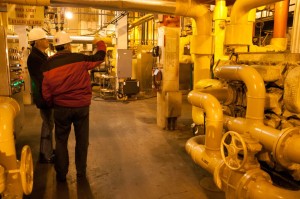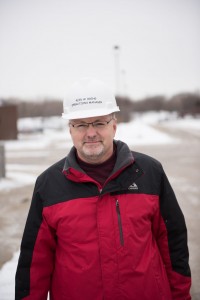Treating area’s waste a massive undertaking
By Kevin Beese For Chronicle Media — January 27, 2016
First in a three-part series looking at how operations at the Metropolitan Water Reclamation District of Greater Chicago – the largest water treatment plant in the world – benefit residents.
Driving along Pershing Road in Stickney, Lakhwinder Hundai, supervising environmental soil scientist with the Metropolitan Water Reclamation District of Greater Chicago, points to a bermed area with some trees and shrubs.
On a cold winter’s day, it is hard to envision anything more than the snow that covers the grounds.
“That is all landscaped,” Hundai said. “People come here and take their wedding pictures. They have no idea of what is behind them.”
Bridal parties, as well as most residents of the Chicago area, have no idea of the operations that go on beyond the berms of the MWRD’s Stickney plant, the largest water treatment plant in the world. The plant serves 2.3 million people in a 260-square-mile area, including Chicago and 43 suburbs.
“Most people don’t think about waste management until their toilet doesn’t flush,” said Reed Dring, engineer of treatment plant operations.
A complex system of pipes, filters, blowers and conveyer belts at the plant is able to treat up to 1.44 billion gallons of water in a day. The average flow of water through the Stickney plant is 727 million gallons of water a day, nearly triple the average of any of the MWRD’s other six plants. The average metropolitan filtration plant treats 500 million gallons of water per day.
“We are No. 1 in the No. 2 business,” Dring joked.

: Reed Dring (right), engineer of treatment plant operations at the Water Reclamation District of Greater Chicago’s Stickney facility, shows Chronicle writer Kevin Beese some of the operations. (Photo courtesy of Water Reclamation District of Greater Chicago)
An all-natural approach keeps water flowing through the plant, Dring stated.
“We use no chemicals,” Dring said. “It is all biotics. We are able to purify 99.9 percent of the water that comes into the plant.”
The treatment facility generates 2.5 million gallons of sludge a day, which a conveyer belt loads into railroad cars. When full, those cars are taken to storage lagoons near Interstate 55 and dumped for the sludge to dry.
Stickney consists of two plants: the west side, which was placed into service in 1930, and the southwest portion of the plant, which was placed in service in 1939.
Think your electric bill is high? How about paying $1.5 million per month? That is what the Stickney plant spend seach month in energy costs.
The plant saves $3 million per year in natural gas costs, with hydrated gas from water treated at the plant being used to heat buildings.
There are 150 tradespeople on staff at the 36-acre Stickney plant to help keep the facility operating.
“Some equipment is from 1939,” Dring said. “You certainly can’t buy parts.”
Operations at the plant are monitored 24 hours a day, seven days a week, Dring said.
“There are always at least 25 people checking things here,” the engineer noted. “At midnight on Christmas, there are 25 people here.”
Six giant pumps, each able to handle 240 million gallons of water a day, can be put into action when heavy rains hit the area. The Deep Tunnel Project, 109 miles of large diameter rock tunnels provides 2.3 billion gallons of volume for combined sewage overflow. Additional flood control measures, including the Gloria Alitto Majewski Reservoir near Chicago’s O’Hare International Airport, the Thornton Reservoir and the under-construction McCook Reservoir will increase storage volume to 17.5 billion gallons of combined sewage overflow.
A phosphorous removal system will go on line at the plant in March, adding to the plant’s ability to generate power.
Dring said he sees plenty of trash in the water when it enters the Stickney plant. The early stages of water treatment pulls plenty of Popsicle sticks and condoms from the flow, he noted.
“And you would not believe the number of catsup packets,” Dring said.
Next week: Keeping water safe
—
Treating area’s waste a massive undertaking —








